Over the course of the summer, I will be examining the matchups and schemes of the Hokies' opponents, and no scheme presents more conundrums and challenges than Nick Saban's NFL-style 3-4 defense. Saban comes from the Bill Parcells/Bill Belichick coaching tree, and brings an NFL-esque attention to detail that is unparalleled in college football. Yes, Alabama has talent, but the true genius of Nick Saban (besides his ability to represent strong the Lollipop Guild) is to ensure that his talent executes the scheme.
Several years ago, Smart Football posted an excerpt from Saban's LSU playbook. While the post has been lost in a sea of bytes, Saban's own words on his defensive philosophy live on (via Pats Propaganda).
[Our] philosophy on first and second down is to stop the run and play good zone pass defense. We will occasionally play man-to-man and blitz in this situation. On third down, we will primarily play man-to-man and mix-in some zone and blitzes. We will rush four or more players versus the pass about ninety-percent of the time.
"In all situations, we will defend the inside or middle of the field first – defend inside to outside. Against the run, we will not allow the ball to be run inside. We want to force the ball outside. Against the pass, we will not allow the ball to be thrown deep down the middle or inside. We want to force the ball to be thrown short and/or outside.
"... Finally, our job is to take the ball away from the opponents' offense and score or set up good field position for our offense. We must knock the ball loose, force mistakes, and cause turnovers.Turnovers and making big plays win games. We will be alert and aggressive and take advantage of every opportunity to come up with the ball ... . The trademark of our defense will be effort, toughness, and no mental mistakes regarding score or situation in any game."
The 3-4 defense describes the alignment of the front seven defenders. Alabama's alignment features a nose tackle lined up heads up or over the strong side eye of the center, and two "defensive ends" lined up over the offensive tackles. On occasion Alabama overloads the strong side by aligning the defensive end to the strong (tight end) side lines up on the inside eye of the tackle, while on the weak side, the end lines up on the outside eye of the guard. Two inside linebackers line up over each guard.

The 3-4 defense is more similar to the Bud Foster 4-2-5 and 4-4 than most recognize. In both defenses, the inside linebackers have straight ahead gap responsibility, and the defensive line forces running backs to go where the defensive coordinator wants them to go. The defensive linemen have similar roles, but execute very differently. Foster uses his four-man front to slant and occupy defenders, while Kirby Smart recruits large defensive linemen that work to tie up blockers, freeing up their linebackers to make plays.
Despite the prevalence of the 3-4 in the NFL, it is a restrictive, assignment based defense for defensive linemen. Their job is to tie up blockers so linebackers can make plays. It is no accident that there has only been one Hall of Fame 3-4 true defensive end (Bruce Smith), several 4-3 ends moved out to weak-side outside linebacker at some point in their careers like Ricky Jackson. Furthermore, no true 3-4 nose tackles have been elected, despite man-mountain's like Ted Washington excelling at the position.
The Nose Tackle
While outside linebackers are the star playmakers in a 3-4 defense, the nose tackle is the most critical in executing the defensive concept. The nose tackle lines up over the center and has gap responsibility for the entire space from the inside shoulder of the left guard to the inside shoulder of the right guard. In most cases, the nose tackle is massive, but more importantly, he must be strong enough and quick enough to neutralize the center and move laterally to tie up the guard that delivers the double team. By completing his assignment he takes away the middle of the box, which should be the most vulnerable part of the defense to the running game. By occupying interior blockers, the nose ensures that the inside linebacker to the play side will be un-blocked, as the defensive end will tie up the offensive tackle.
Saban will also throw a curveball at the offense and shift to a four-man front.
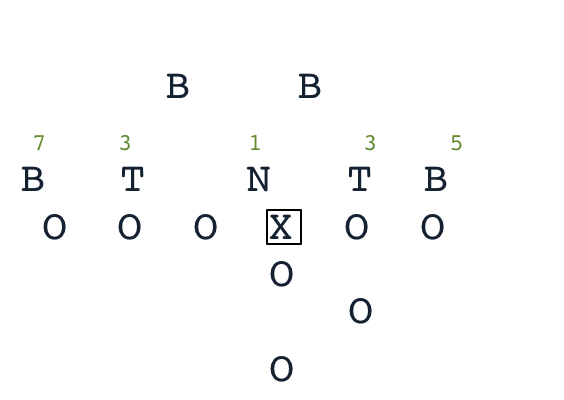
Here Auburn (and Scot Loeffler) try to run the insize zone against Alabama last season.
36:47–37:14
Watch the nose tackle, #54 Jesse Williams. At the snap, Williams takes on the center and gets double teamed by the backside guard. Williams occupies the center initially and then stands his ground taking on the guard. He resists getting too far up the field, where the guard can get on his hip and create a cutback lane. The center can't get to the second level in time to create a bubble for the back, and he has nowhere to go.
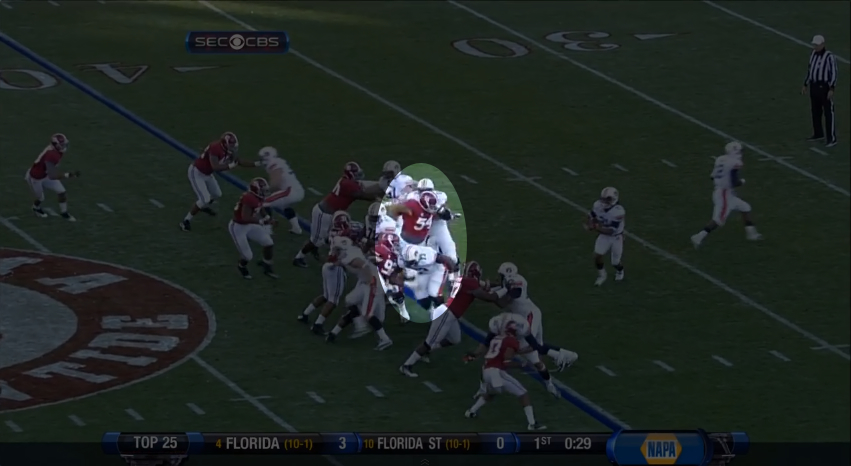
Auburn took an interesting tactic against the 3-4 early in the game. During the first series of the game, Auburn's offensive line made every effort to completely bypass the nose tackle with the center and block him with the back side guard.
18:55–20:08
If Loeffler intends to use the same strategy on August 31st, it presents a huge challenge for the footwork and strength of Mark Shuman, Brent Benedict, and David Wang. It requires the guard to not only be physically strong enough to handle 6-4, 310-pound sophomore nose tackle Brandon Ivory, but the guard must also take a lateral step and cover nearly 5 feet of space, then move Ivory horizontally. With the 3-4 outside linebacker playing outside the tight end, the interior is much more susceptible to interior running plays IF the Hokies can handle the nose. This will be the most important matchup on the field, and Virginia Tech's track record against quality defensive tackles is abysmal since dominating Dan Williams in the 2009 Peach Bowl.
Saban will also use a four man front on passing downs, or against spread formations. On early downs, the nose tackle stays on the field. The fundamentals of the defense remain the same, but sometimes one linebacker will move into a 4-3 end position and put his hand down. When the Tide goes to a 4-man front, the nose slides over to play a 1 or 3 technique (lined up on the inside or outside eye of the guard). In that role he will still most likely be playing a 2-gap technique, occupying the guard along with the double team blocker assigned to combination block.
Defensive Ends
In the base 3-4, the defensive end does not play in the Deacon Jones style classic edge rusher mold. 3-4 ends are more like defensive tackles. Similar to the nose tackle, the defensive ends have two-gap responsibility. The ends line up over the offensive tackles. The defensive end must occupy the gaps to the inside and outside shoulder of the tackle. On occasion, the end will line up on the outside eye of the tackle. This is more common on the strong side of the line where the tight end is lined up. Regardless of the alignment, the defensive end must occupy the offensive tackle and if the tight end is on his side he may also neutralize a double team. Just like the nose, the defensive end's primary assignment is not to make tackles, rather occupy blockers. The end only gets up field if he reads pass. As a result these guys won't put up big numbers.
When Kirby Smart shifts to the four man front, one of the defensive ends must slide down to play a 1 or a 3 technique just like the nose tackle. This flexibility requires most 3-4 ends to have a very similar body type to a 4-3 defensive tackle. Alabama recruits tall, strong side defensive ends and tackles who come out of high school around 6-4, 250-260 pounds, but with frames to carry much more weight. The typical Alabama end grows to the 280-300 pound range. Jeoffrey Pagan (6-4, 290, JR) and Ed Stinson (6-4, 292, SR) will start at defensive end for the Tide. Both were four-star recruits.
Not only do the ends tie up blockers straight up, but they work to create blitzing lanes as well. Here, we see a designed 3-4 run blitz designed to stop the zone stretch play.
37:14–37:51
The design is pretty simple. Auburn runs a fake quick pass right, then opens up and pitches the ball back to the left. Auburn must have had a strong tendency to run back to the trips side, because Alabama looks like they audibled to a mike blitz. On the play, the defensive end stunts hard to the inside, crossing the left tackles face and sealing the guard inside, almost like a trap block by an offensive guard. The linebacker then shoots through the gap, and with the tackle fixated on the stunt, the linebacker blows through the hole and crushes the tailback. (We will discuss how the outside linebacker keeps contain in our next segment.)
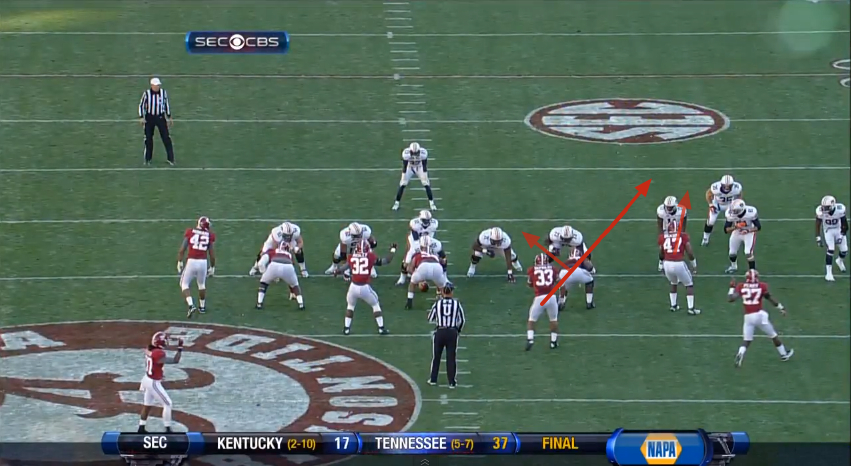
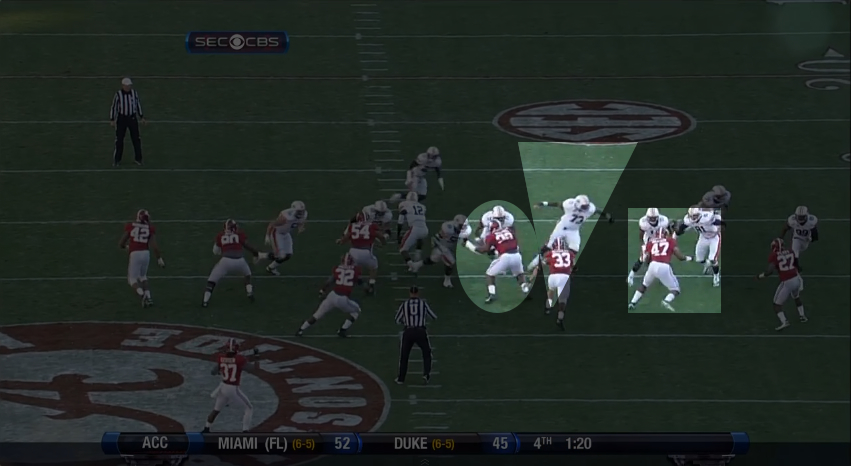
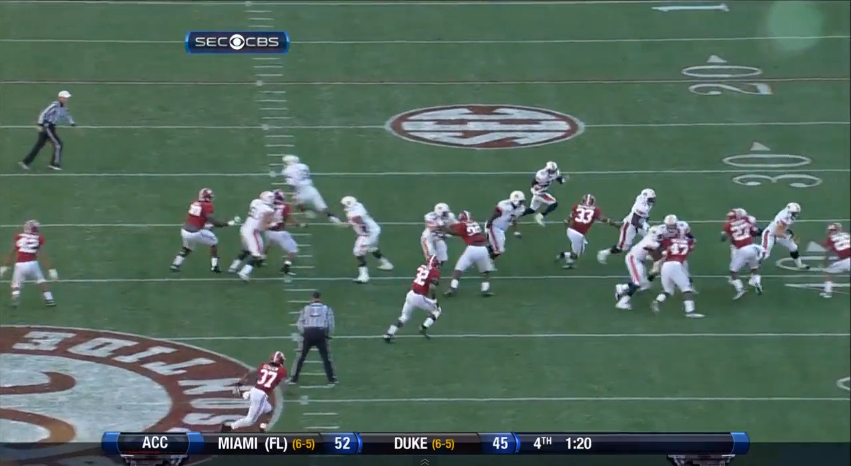
As you can see, the ends are doing the thankless work that allows the inside linebacker to make the play. At the same time, they have the talent to beat blocks individually, and Smart will shift to a four man front and allow them to get upfield, especially on long yardage downs. These ends will be the largest defenders that Jonathan McLaughlin, Laurence Gibson, and Ryan Malleck will see all season, and Alabama will do whatever they can to not only physically dominate the young tackles, but confuse them as well.
In the past, I have commented that the Hokies offensive line is sometimes at a disadvantage in early season blocking matchups because of the amount of time they must devote in preseason blocking Bud Foster's slanting gap scheme. Foster's defense presents many of the challenges that a defense faces when playing the Georgia Tech offense, in that in order to succeed against it you must change your fundamentals, and often it messes up your scheme later in your schedule. The Hokie blockers will face defenders slanting and stunting during the first couple of weeks. Then, as they shift to gameplan preparations against Alabama, they must adjust to physical defensive linemen who stand their ground and challenge double teams. Also, the Hokies do not have the depth at defensive line to simulate the size and strength of Alabama to accurately give the offensive line a good look. Tech has a decent track record of success attacking a 3-4 against Georgia Tech, UVA under Al Groh, and more recently Boston College, but those teams do not present the size, strength, athleticism, or attention to detail that Alabama will bring to the table. The Hokies must follow their blocking rules, and unlike last season, compete on every block to win this football game. If Tech can run inside the tackles, they have a good chance. If they have to resort to throwing the ball 40 times, it allows Kirby Smart to use those pass rushing linebackers and disguised coverage to force turnovers. We will discuss some of those schemes in my next article.


Comments
Please join The Key Players Club to read or post comments.
Please join The Key Players Club to read or post comments.
Please join The Key Players Club to read or post comments.
Please join The Key Players Club to read or post comments.
Please join The Key Players Club to read or post comments.
Please join The Key Players Club to read or post comments.
Please join The Key Players Club to read or post comments.
Please join The Key Players Club to read or post comments.
Please join The Key Players Club to read or post comments.
Please join The Key Players Club to read or post comments.
Please join The Key Players Club to read or post comments.
Please join The Key Players Club to read or post comments.
Please join The Key Players Club to read or post comments.
Please join The Key Players Club to read or post comments.
Please join The Key Players Club to read or post comments.
Please join The Key Players Club to read or post comments.
Please join The Key Players Club to read or post comments.
Please join The Key Players Club to read or post comments.
Please join The Key Players Club to read or post comments.
Please join The Key Players Club to read or post comments.
Please join The Key Players Club to read or post comments.
Please join The Key Players Club to read or post comments.
Please join The Key Players Club to read or post comments.
Please join The Key Players Club to read or post comments.
Please join The Key Players Club to read or post comments.
Please join The Key Players Club to read or post comments.
Please join The Key Players Club to read or post comments.
Please join The Key Players Club to read or post comments.
Please join The Key Players Club to read or post comments.
Please join The Key Players Club to read or post comments.
Please join The Key Players Club to read or post comments.
Please join The Key Players Club to read or post comments.
Please join The Key Players Club to read or post comments.
Please join The Key Players Club to read or post comments.
Please join The Key Players Club to read or post comments.
Please join The Key Players Club to read or post comments.
Please join The Key Players Club to read or post comments.
Please join The Key Players Club to read or post comments.
Please join The Key Players Club to read or post comments.
Please join The Key Players Club to read or post comments.
Please join The Key Players Club to read or post comments.
Please join The Key Players Club to read or post comments.
Please join The Key Players Club to read or post comments.
Please join The Key Players Club to read or post comments.
Please join The Key Players Club to read or post comments.
Please join The Key Players Club to read or post comments.
Please join The Key Players Club to read or post comments.
Please join The Key Players Club to read or post comments.
Please join The Key Players Club to read or post comments.
Please join The Key Players Club to read or post comments.